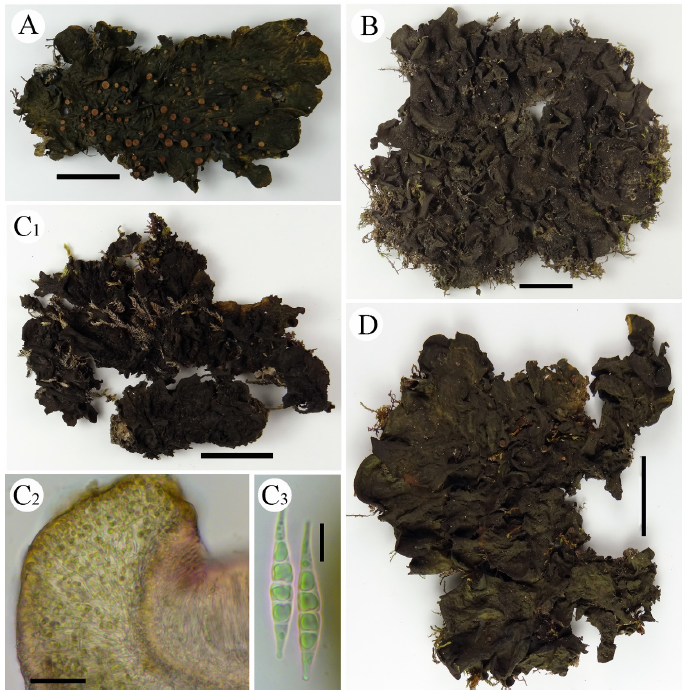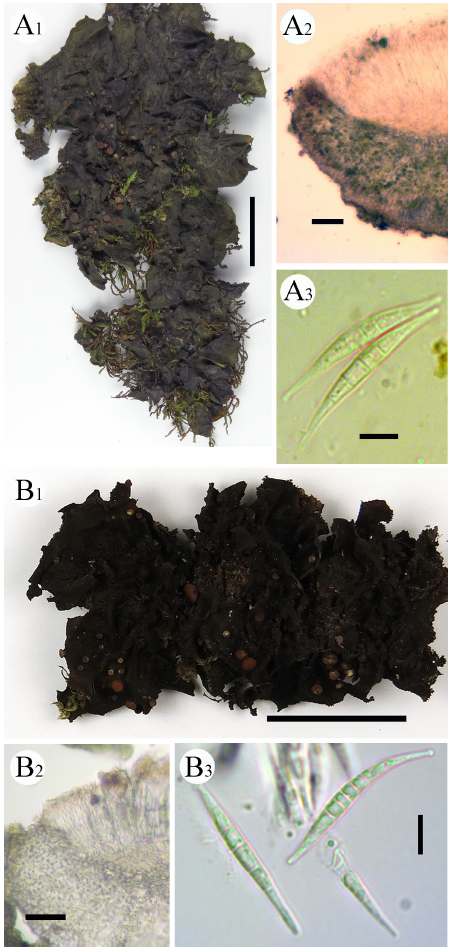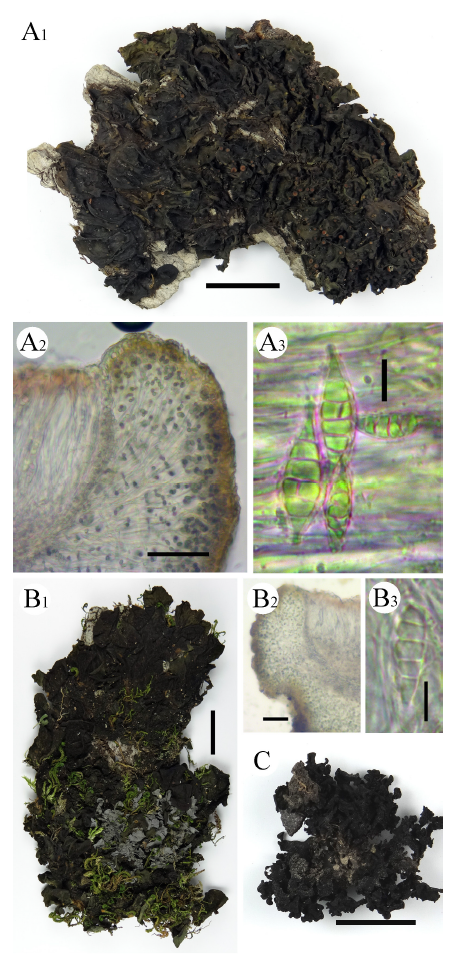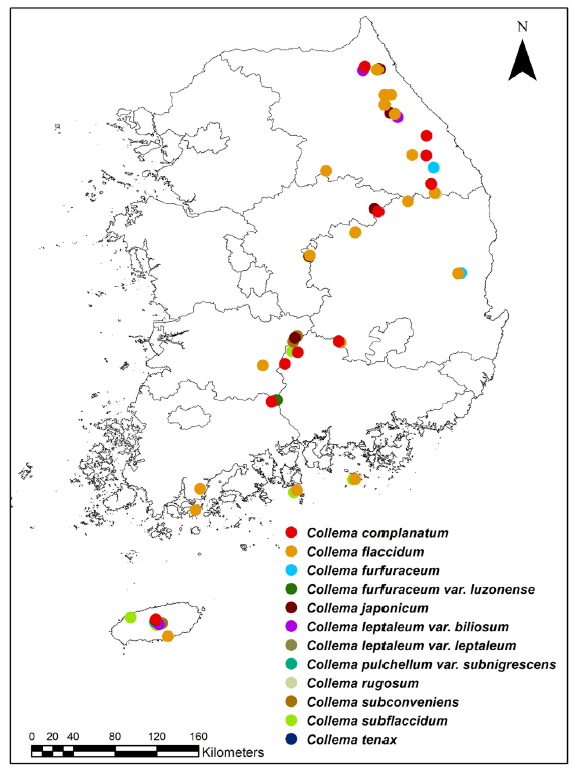INTRODUCTION
Collema Weber ex F.H. Wigg is a widespread cosmopolitan lichen-forming fungal genus in the family, Collemataceae [1]. This genus is characterized by the presence of foliose, sub-fruticose to almost crustose ecorticate, homoiomerous thallus; cyano-bacterial matrix; terete isidia; flat, dorsiventral, sometimes terete, lobules; immersed to sessile, subpedicellate to pedicellate apothecia with round disc and proper exciple; clavate to subcylindrical, 8-spored, unitunicate, I+ blue asci; transversely septate, 1 to many septa or muriform, thin-walled, hyaline spores; and globose, immersed pycnidia with rod-like conidia [2,3].
The genus Collema is very closely related to the genus Leptogium in external appearance; however, the latter can be distinguished by the presence of cortical layers on either sides of its thallus [4,5]. According to Gilbert et al. [3], identifying the Collema species is difficult as these species have considerable variation in their morphology. Furthermore, recent phylogenetic studies revealed that both Collema and Leptogium are not monophyletic genera [6,7]. Several studies on the genus, Collema, have been carried out by several authors [2,3,8-13] and 80 species have been identified to date in this genus [5,14].
In South Korea, no comprehensive work has been carried out on Collema, and only very little information has been reported for most of these South Korean species. According to previous literature, ten species have already been reported [15]. These species include C. complanatum Hue, C. fasciculare (L.) Weber ex F.H. Wigg., C. flaccidum (Ach.) Ach., C. furfuraceum Du Rietz, C. japonicum (Müll. Arg.) Hue, C. leptaleum var. biliosum (Mont.) Degel., C. nigrescens (Huds.) DC., C. peregrinum Degel., C. shiroumanum Yasuda ex Räsänen, and C. subflaccidum Degel. The present study sought to unveil five more species, namely C. furfuraceum var. luzonense (Räsänen) Degel., C. pulchellum var. subnigrescens (Müll. Arg.) Degel., C. rugosum Kremp., C. subconveniens Nyl., and C. tenax (Sw.) Ach., and one variety, C. leptaleum var. leptaleum Tuck. A revised key to the hitherto known species of Collema from South Korea is provided based on the current study and the available literature (the newly recorded species are in bold).
MATERIALS AND METHODS
The study was based on specimens deposited in the lichen herbarium at Korean Lichen Research Institute (KoLRI), Sunchon National University. The specimens were transferred to the Herbarium of Korea National Arbortrum (KH), South Korea in 2016. A NIKON SMZ645 dissecting microscope (Nikon Corp., Tokyo, Japan) was used to identify the morphological characteristic of thallus, reproductive structures, color, size, and shapes, while a ZEISS Scope A1 compound microscope (Carl Zeiss, Oberkochen, Germany) was used to analyze the anatomy of thalli and ascomata. Spot test reactions were also carried out on the thallus under the compound microscope.
Lichen substances were extracted using analytical grade acetone in a 1 mL Eppendorf tube. Thin layer chromatography (TLC) was performed using glass plate coated with TLC Silica gel 60 in solvent system A (toluene:dioxin:acetic acid 180:45:5) [16].
RESULTS AND DISCUSSION
Species Dscription
Collema complanatum Hue, Zahlbruckner's Cat. Lich. Univ. 3:34 (1906).
Thallus foliose, closely adnate, 3-10 cm wide, 50-60 μm thick, dark olive green to blackish. Lobes round to oblong, 4-8 mm wide; margins entire; densely to sparsely ridged, surface somewhat smooth, isidia, lobules absent. Apothecia scattered to crowded, on ridges and center of the thallus, shortly pedicellate, 1-2 mm wide; disc convex to flat, pale to dark red-brown, epruinose; thalline exciple smooth, pale brown. Ascospores linear-oblong, straight or somewhat curved, 6-10 celled, often narrowing toward one end, 75-80×3-4 μm; pycnidia immersed on the submarginal zone, conidia dumbbell shape, 3.5-4×0.6-0.7 μm (Fig. 1-1A).
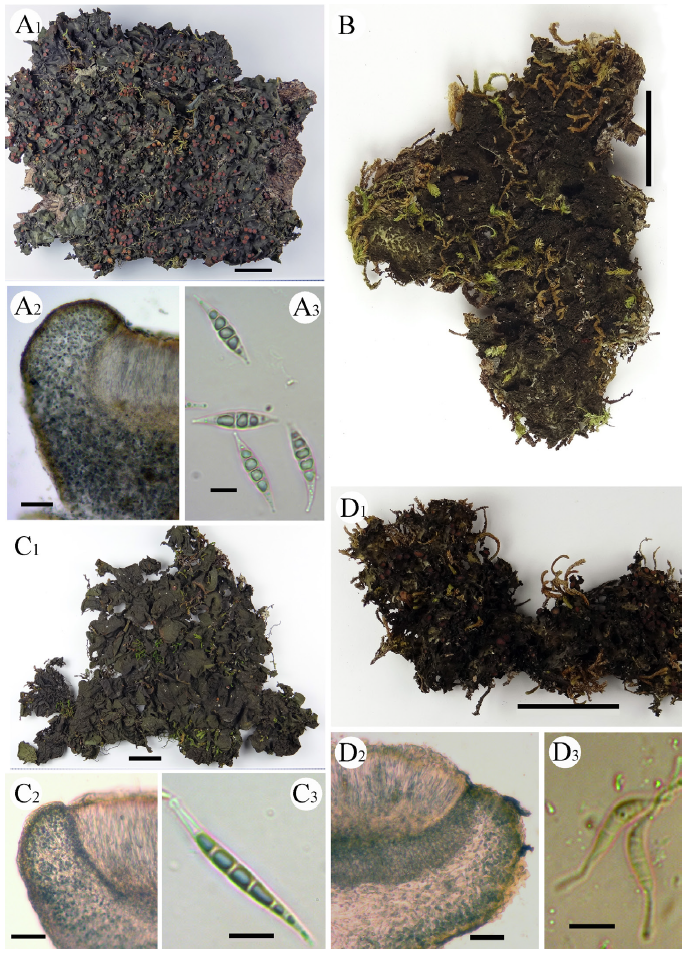
Fig. 1-2. A: Collema japonicum; A1, habitus; A2, section through the apothecium margin; A3, ascospores. B: C. leptaleum var. biliosum Habitus. C: C. leptaleum var. leptaleum; C1, habitus; C2, section through the apothecium margin; C3, ascospores. D: C. nigrescens; D1, habitus; D2, section through the apothecium margin; D3, ascospores. Scales: A1, B, C1, D1=1 cm; A2, C2, D2=50 μm; A3, C3, D3=10 μm.
Chemistry: Single unknown chemical was identified by TLC (Fig. 2).
Ecology and Distribution: This species has been found on tree bark at elevation ranges greater than 400 m in South Korea. Many of this species was found in Halla and Hambaek Mountains (Fig. 3). C. complanatum was identified for the first time in South Korea by Park [17]. Besides South Korea, this species has been identified in other East Asian countries, including North Korea [18], China, Taiwan [13,19], and Japan [20].
Remarks: C. complanatum is characterized by the presence of olive green, ridged, thallus without isidia and long fusiform transversely septate spores. This species is similar to C. pulchellum var. subnigrescens in external appearance; however, the latter has shorter spores (<65 μm).
Specimens examined: South Korea, Jeollanam-do (province), Gwangyang-si (city), Mt. Baekun, 35°37'07.5"N, 127°39'40.7"E, elev. 1,042 m, on bark (Quercus sp.), X.Y. Wang, H.S. Jeon, G.S. Han–100452 (KoLRI 012071), June 24, 2010; South Korea, Gyeongsangnam-do (province), Hapcheon-gun (county), Mt. Gaya, 35°48'47.0"N, 128°07'31.1"E, elev. 500 m, on bark (Quercus sp.), J.S. Hur–060123 (KoLRI 004495), May 05, 2006; South Korea, Gyeongsangnam-do (province), Hamyang-gun (county), Mt. Geumwon, 35°43'7.22"N, 127°46'18.4"E, elev. 1,253 m, on bark (Quercus sp.), X.Y. Wang, H.S. Jeon, G.S. Han–100507 (KoLRI 012107), June 25, 2010; South Korea, Jeju-do (province), Jeju-do (island), South Korea, Jeju-do (province), Jeju-si (city), Odong-dong, Mt. Halla, 33°25'04.0"N, 126°32'52.0"E, elev. 619 m, on bark, S.O. Oh, U. Jayalal, J.S. Park, J.S. Hur–120951 (KoLRI 015981), June 01, 2012; South Korea, Gangwon-do (province), Taebaek-si (city), Mt. Hambaek, 37°10'04.3"N, 128°54'57.9"E, elev. 1,488 m, on bark, J.S. Hur–070746 (KoLRI 007596), June 19, 2007; South Korea, Jeollanam-do (province), Gurye-gun (county), Mt. Jiri, 35°17'34.5"N, 127°32'45.6"E, elev. 1,400 m, on bark (Quercus sp.), J.S. Hur–060231 (KoLRI 004608), June 17, 2006; South Korea, Gangwon-do (province), Gangneung-si (city), Mt. Seokbyeong, 37°35'02.2"N, 128°52'29.1"E, elev. 901 m, on bark, J.S. Hur–080233 (KoLRI 008479), May 24, 2008; on bark, 37°24'51.3"N, 128°52'22.9"E, elev. 869 m, J.S. Hur–080222 (KoLRI 008468), May 24, 2008; South Korea, Gyeongsangbuk-do (province), Danyang-gun (county), Mt. Sobaek, 36°55'48.4"N, 128°27'45.7"E, elev. 1,359 m, on bark, J.S. Hur–070342 (KoLRI 007487), April 25, 2007; South Korea, Gangwon-do (province), Inje-gun (county), Mt. Seolark, Baekdam temple, 38°10'47.5"N, 128°21'02.7"E, elev. 435 m, on bark, J.S. Hur–041541(KoLRI 002336), October 11, 2004.
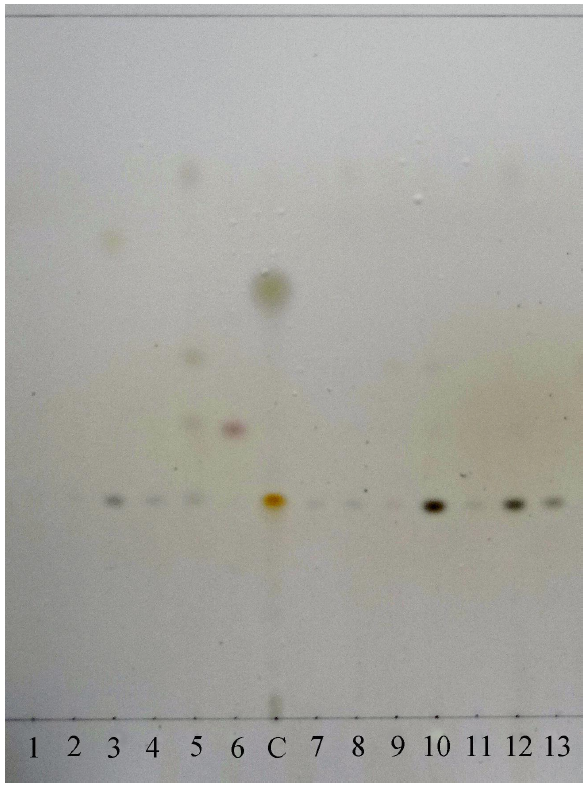
Fig. 2. Thin layer chromatography (TLC) profile of the Collema species in the solvent system A. 1: Collema complanatum. 2: C. flaccidum. 3: C. furfuraceum. 4: C. furfuraceum var. luzonense. 5: C. japonicum. 6: C. leptaleum var. biliosum. 7: C. leptaleum var. leptaleum. 8: C. nigrescens. 9: C. pulchellum var. subnigrescens. 10: C. rugosum. 11: C. subconveniens. 12: C. subflaccidum. 13: C. tenax. C: Control (Lethariella cladonioides [Nyl.] Krog) with atranorin, and norstictic acid.
Collema flaccidum(Ach.) Ach., Lich. Univ.: 647 (1810).
Thallus foliose, closely adnate, 3-5 cm wide, 60-80 μm thick, dark olive green. Lobes round to oblong, 4-8 mm wide; margins entire; surface smooth without pustules or ridges, surface somewhat smooth, isidiate. Isidia squamuliform. Apothecia not seen. Pycnidia immersed on the submarginal zone, conidia dumbbell shape, 3.0-4.2×0.8-1.2 μm (Fig. 1-1B).
Chemistry: Single unknown chemical was identified via TLC (Fig. 2).
Ecology and Distribution: C. flaccidum is a common species on barks and rocks at all low and high elevations (Fig. 3). This species was identified for the first time in South Korea by Park [21]. Besides South Korea, this species has been found in other East Asian countries, including North Korea [18], China [13,19], and Japan [20].
Remarks: C. flaccidum is characterized by the presence of olive green, smooth thallus with squamuliform isidia. This species is similar to C. subflaccidum in external appearance; however, the latter has globular isidia.
Specimens examined: South Korea, Jeollanam-do (province), Hwasun-gun (county), Mt. Baega, 34°32'33.1"N, 126°55'46.7"E, elev. 334 m, on rock, J.S. Hur–050560 (KoLRI 003464), October 08, 2005; South Korea, Gangwon-do (province), Jeongseon-gun (county), Yeorang-myon, Mt. Bannon, 37°25'9.82"N, 128°45'07.8"E, elev. 622 m, on rock, X.Y. Wang, H.S. Jeon, Lv Lei, J.A. Ryu–100772 (KoLRI 012471), May 28, 2010; South Korea, Gangwon-do (province), Wonju-si (city), Mt. Chiak, 37°16'59.8"N, 128°01'05.1"E, elev. 465 m, on bark, J.S. Hur–040557 (KoLRI 001341), August 13, 2004; South Korea, Gangwon-do (province), Hongcheon-gun (county), Mt. Eungbok, 37°51'7.01"N, 128°31'4.89"E, elev. 691 m, on rock, Y. Joshi, X.Y. Wang, J.A. Ryu–090698 (KoLRI 010367), May 23, 2009; South Korea, Gyeongsangnam-do (province), Hapcheon-gun (county), Mt. Gaya, 35°48'11.9"N, 128°08'35.0"E, elev. 500 m, on rock, J.S. Hur–060094 (KoLRI 004466), May 05, 2006; South Korea, Gangwon-do (province), Yangyang-gun (county), Mt. Jobong, 37°56'10.7"N, 128°33'74.7"E, elev. 980 m, on bark, Y. Joshi, X.Y. Wang, J.A. Ryu, J.Y. Hur–090249 (KoLRI 010003), May 14, 2009; South Korea, Gyeongsangbuk-do (province), Cheongsong-gun (county), Mt. Juwang, 36°23'51.8"N, 129°08'56.1"E, elev. 280 m, on rock, J.S. Hur–050610 (KoLRI 003514), October 15, 2005; South Korea, Gyeongsangbuk-do (province), Mungyeong-si (city), Mt. Gongdeog, 36°45'10.9"N, 128°16'09.1"E, elev. 920 m, on bark (Quercus sp.), J.S. Hur–070822(KoLRI 012831), June 20, 2007; South Korea, Gangwon-do (province), Pyeongchang-gun (county), Mt. Odae, 37°46'17.2"N, 128°36'04.1"E, elev. 1,454 m, on bark, J.S. Hur–080553 (KoLRI 008771), July 15, 2008; South Korea, Jeollabuk-do (province), Jangsu-gun (county), Mt. Palgong, 35°36'18.7"N, 127°28'14.2"E, elev. 873 m, on bark, J.S. Hur–050409 (KoLRI 003313), September 10, 2005; South Korea, Gangwon-do (province), Sokcho-si (city), Mt. Seolark, 38°09'9.81"N, 128°27'26.7"E, elev. 463 m, on bark (Quercus sp.), Y. Joshi, X.Y. Wang, J.A. Ryu–090819 (KoLRI 010491), May 24, 2009; South Korea, Chungcheongbug-do (province), Boeun-gun (county), Mt. Songni, 36°33'07.9"N, 127°52'33.5"E, elev. 1030 m, on bark (Quercus sp.), J.S. Hur–060082 (KoLRI 004454), April 22, 2006; South Korea, Gyeongsangbuk-do (province), Bonghwa-gun (county), Mt. Seondal, 37°01'10.2"N, 128°42'49.7"E, elev. 578 m, on rock, J.S. Hur–070224 (KoLRI 007206), April 24, 2007; South Korea, Gyeongsangbuk-do (province), Taebaek-si (city), Mt. Taebaek, 37°05'31.6"N, 128°56'46.9"E, elev. 1,445 m, on bark (Quercus sp.), J.S. Hur–070583 (KoLRI 007426), June 18, 2007; South Korea, Jeollanam-do (province), Yeosu-si (city), Geumo-do (island), 34°31'55.0"N, 127°45'55.0"E, elev. 11 m, on rock, U. Jayalal, J.S. Park, J.A. Ryu–120521 (KoLRI 015513), April 27, 2012; South Korea, Jeju-do (province), South Korea, Jeju-do (province), Seogwipo-si (city), Napwon-eup (town), Wimi-ri, 33°16'22.1"N, 126°39'6.50"E, elev. 10 m, on rock, J.S. Hur, X.Y. Wang, Y. Joshi–091415 (KoLRI 011058), 091439 (KoLRI 011082), May 29, 2009; South Korea, Jeollanam-do (province), Wando-gun (county), Joyag-do (island), 34°21'36.0"N, 126°53'27.0"E, elev. 3 m, on rock, U. Jayalal, J.S. Park, J.A. Ryu–120134 (KoLRI 014728), April 18, 2012; South Korea, Gyeongsangnam-do (province), Tongyeong-si (city), Yokji-do (island), 34°37'34.0"N, 128°16'06.0"E, elev. 32 m, on rock, S.O. Oh, U. Jayalal, J.S. Park, J.A. Ryu–120888 (KoLRI 015886), May 11, 2012; South Korea, Gangwon-do (province), Yangyang-gun (county), Micheongol (valley), 37°56'10.6"N, 128°31'8.87"E, elev. 420 m, on mossy rock, Y. Joshi, X.Y. Wang, J.A. Ryu, J.Y. Hur–090314 (KoLRI 010049), May 14, 2009.
Collema furfuraceum Du Rietz, Ark. Bot. 22A(13): 5 (1929).
Thallus foliose, closely adnate, 2-8 cm wide, 60-70 μm thick, dark olive-green to blackish. Lobes round to oblong, 4-8 mm wide; margins entire; densely to sparsely ridged, surface somewhat smooth, isidiate. Isidia cylindrical to globose, never lobulate. Apothecia not seen. Pycnidia immersed on the thallus, conidia rod to dumbbell shape, 4.0-4.3×0.8-1.05 μm (Fig. 1-1C).
Chemistry: Two unknown chemicals were identified via TLC (Fig. 2).
Ecology and Distribution: This species has been found on tree bark at mid to high elevations (Fig. 3) and was first identified in South Korea by Park [21]. Besides South Korea, this species has been identified in other East Asian countries, including China [13] and Japan [20].
Remarks: C. furfaraceum is characterized by the presence of olive green, ridged, thallus with cylindrical to globose isidia. This species is similar to C. flaccidium and C. subflaccidium in external appearance; however, the latter has somewhat smooth thallus without ridges. According to the cell shape of the proper exciple, two varieties have been recognized by Wu & Liu [13]. Due to the lack of apothecia, further verification up to the variety level was difficult to achieve. Therefore, the above specimens were named up to the species level.
Specimens examined: South Korea, Gyeongsangbuk-do (province), Cheongsong-gun (county), Mt. Juwang, 36°24'09.6"N, 129°10'27.0"E, elev. 380 m, on rock, J.S. Hur–050604 (KoLRI 003508), October 15, 2005; South Korea, Gangwon-do (province), Samcheok-si (city), Hajang-myon(Twon), Gitdaebong, 37°18'36.7"N, 128°56'7.66"E, elev. 1,222 m, on bark, Y. Joshi, X.Y. Wang, J.A. Ryu, J.Y. Hur–090389 (KoLRI 010105), May 15, 2009.
Collema furfuraceum var. luzonense (Räsänen) Degel., Symb. Bot.Upsal. 20(2): 179 (1974).
Thallus foliose, closely adnate, 4-7 cm wide, 60-70 μm thick, dark olive-green to blackish. Lobes round to oblong, 4-10 mm wide; margins entire; densely to sparsely ridged, surface somewhat smooth, isidiate. Isidia cylindrical to globose. Apothecia present, rare, on ridges and center of the thallus, shortly pedicellate, 0.5-1 mm wide; disc convex to flat, pale to dark red-brown, epruinose; thalline exciple smooth, pale brown, euparaplectenchymatous. Ascospores fusiform to broadly acicular, straight, 6 celled, 41-47×5.5-6.7 μm; pycnidia immersed on the thallus, conidia dumbbell shape, 3.5-4×0.6-0.7 μm (Fig. 1-1D).
Chemistry: Single unknown chemical was identified via TLC (Fig. 2).
Ecology and Distribution: This is the first report of this variety in South Korea. Further, this variety was identified at a single locality at Mt. Jiri (Fig. 3). Besides South Korea, this variety has been identified in other East Asian countries, including China [13].
Remarks: C. furfuraceum var. luzonense is characterized by the presence of olive green, ridged, thallus with cylindrical to globose isidia, and apothecial exciple with paraplectenchymatous cells. This variety is very similar to C. furfuraceum var furfuraceum in external appearance; however, the latter has euthyplectenchymatous cells in the exciple [13].
Specimens examined: South Korea, Gyeongsangnma-do (province), Hadong-gun (county), Mt. Jiri, 35°18'28.9"N, 127°35'30.6"E, elev. 1,408 m, on bark (Quercus sp.), J.S. Hur–060815 (KoLRI 005197), September 28, 2006.
Collema japonicum (Müll. Arg.) Hue, Nouv. Arch. Mus. Hist. Nat., Paris, 3 Sér. 10: 220 (1898).
Thallus foliose, closely adnate, 3-10 cm wide, 60-80 μm thick, dark olive-green. Lobes round to oblong, 0.5-1.2 cm wide; margins entire; surface smooth without pustules or ridges, sparsely lobulate rarely isidiate. Apothecia crowded, on ridges and center of the thallus, shortly pedicellate, 1-2 mm wide; disc convex to flat, pale to dark red-brown, epruinose; thalline exciple smooth, pale brown. Ascospores broadly acicular, straight, 6 celled, 36-54×4-6 μm; pycnidia immersed on the thallus, conidia somewhat dumbbell shape (swollen toward the ends), 3.5-4.2×0.7-1.03 μm (Fig. 1-2A).
Chemistry: Four unknown chemicals were identified via TLC (Fig. 2).
Ecology and Distribution: C. japonicum is a common species on barks and rocks at low and higher elevations (Fig. 3). This species was identified for the first time in South Korea by Degelius [9]. Besides, South Korea, this species has been found in other East Asian countries, including North Korea [18], Taiwan, China [13,19], and Japan [20].
Remarks: C. japonicum is characterized by the presence of olive green, smooth thallus with rarely present isidia, or lobules, and broadly acicular spores. This species is similar to C. flaccidum in external appearance; however, the former species rarely has isidia and euparaplectenchymatous thalline exciple.
Specimens examined: South Korea, Jeollabuk-do (province), Muju-gun (county), Mt. Deogyu, 35°50'34.3"N, 127°44'49.1"E, elev. 1,482 m, on bark (Quercus sp.), J.S. Hur–060517 (KoLRI 004888), August 10, 2006; South Korea, Gyeongsangnam-do (province), Hapcheon-gun (county), Mt. Gaya, 35°48'54.4"N, 128°07'32.5"E, elev. 1,190 m, on bark (Quercus sp.), J.S. Hur–060135 (KoLRI 004507), May 05, 2006; South Korea, Jeju-do (province), Jeju-si (city), Odong-dong, Mt. Halla, on bark, 33°24'39.0" N 126°32'47.0"E, elev. 739 m, S.O. Oh, U. Jayalal, J.S. Park, J.S. Hur–120991 (KoLRI 016021), August 01, 2012; South Korea, Gangwon-do (province), Taebaek-si (city), Mt. Hambaek, 37°10'15.8"N, 128°54'53.7"E, elev. 1,413 m, on bark, J.S. Hur–070732 (KoLRI 007584), June 19, 2007; South Korea, Gyeongsangnma-do (province), Hadong-gun (county), Mt. Jiri, 35°18'26.7"N, 127°35'20.3"E, elev. 1,270 m, on bark (Acer sp.), J.S. Hur–060339 (KoLRI 004711), June 18, 2006; South Korea, Gangwon-do (province), Pyeongchang-gun (county), Mt. Odae, 37°46'22.4"N, 128°36'05.8"E, elev. 1,418 m, on bark, J.S. Hur–080585 (KoLRI 008799), July 15, 2008; 37°46'54.1"N, 128°33'38.0"E, elev. 965 m, on bark (Quercus sp.), J.S. Hur–040433 (KoLRI 001211), May 07, 2004; South Korea, Gyeongsangbuk-do (province), Danyang-gun (county), Mt. Sobaek, 36°57'21.3"N, 128°26'02.5"E, elev. 495 m, on mossy rock, J.S. Hur–030699 (KoLRI 000499), October 01, 2003; South Korea, Chungcheongbug-do (province), Boeun-gun (county), Mt. Songni, 36°32'47.3"N, 127°52'15.2"E, elev. 850 m, on bark, J.S. Hur–060059 (KoLRI 004431), April 22, 2006; South Korea, Gangwon-do (province), Sokcho-si (city), Mt. Seolark, 38°09'27.7"N, 128°28'21.0"E, elev. 380 m, on mossy bark, J.S. Hur–050281 (KoLRI 003185), June 17, 2005.
Collema leptaleum var. biliosum (Mont.) Degel., Symb. Bot. Upsal. 20(2): 105 (1974).
Thallus crustose to sub-foliose, closely to loosely adnate, membranous, 3-4 cm wide, 80-400 μm thick, olive green to yellowish brown. Margins lobulate, lobules 1-2 mm wide, short, narrow; surface matt or glossy, smooth to irregularly rugose, isidiate. Isidia globose, single to branched, scattered all over the upper surface. Apothecia and pycnidia were not seen. (Fig. 1-2B).
Chemistry: Two unknown chemicals were identified via TLC (Fig. 2).
Ecology and Distribution: C. leptaleum var. biliosum is a somewhat rare species in South Korea and has only been found on tree barks at mid to high elevation (Fig. 3). This variety was first identified in South Korea by Degelius [9]. Besides South Korea, this variety has been found in other East Asian countries, including Taiwan, China [13,19], and Japan [20].
Remarks: C. leptaleum var. biliosum is characterized by the presence of olive green to yellowish brown, subcrustose, fenestrate thallus with globose isidia. This variety is very similar to C. leptaleum var. leptaleum in external appearance; however, the latter species does not have isidia.
Specimens examined: South Korea, Jeju-do (province), Jeju-si (city), Ara-1-dong, Mt. Halla, 33°22'28.5"N, 126°34'31.3"E, elev. 1,165 m, on bark, J.S. Hur–040796 (KoLRI 001578), August 28, 2004; South Korea, Gangwon-do (province), Pyeongchang-gun (county), Mt. Hwangbyeong, 37°44' 44.3" N, 128°37'30.4"E, elev. 779 m, on bark, J.S. Hur–080369 (KoLRI 008623), July 14, 2008; South Korea, Gangwon-do (province), Yangyang-gun (county), Micheongol (valley), 37°56'10.6"N, 128°31'8.77"E, elev. 420 m, on rock, Y. Joshi, X.Y. Wang, J.A. Ryu, J.Y. Hur–090316 (KoLRI 010051), May 14, 2009; South Korea, Gangwon-do (province), Inje-gun (county), Mt. Seolark, 38°08'53.5"N, 128°20'05.3"E, elev. 1,010 m, on bark, J.S. Hur–050278 (KoLRI 003181), April 16, 2005.
Collema leptaleum var. leptaleum Tuck., Proc. Amer. Acad. Arts & Sci. 6: 263 (1866).
Thallus crustose to sub-foliose, closely to loosely adnate, membranous, 2-6 cm wide, 60-100 μm thick, dark olive green to yellowish brown. Margins lobulate, lobules 1-2 mm wide, short, narrow; surface matt or glossy, smooth to irregularly rugose, non-isidiate. Apothecia crowded on the sub-marginal zone and center of the thallus, shortly pedicellate, 1-2 mm wide; disc concave to flat, pale to dark red-brown, epruinose; thalline exciple blackish, lobulate. Ascospores linear-oblong, straight to curved, narrowing toward both ends, 4 celled, 38-42×3.5-5 μm; pycnidia immersed on the thallus, conidia somewhat broad, dumbbell shape (swollen toward the ends), 2.6-3.35×1.1-1.35 μm (Fig. 1-2C).
Chemistry: Two unknown chemicals were identified via TLC (Fig. 2).
Ecology and Distribution: C. leptaleum var. leptaleum is a rare species in South Korea that has only been found on tree bark at high elevation (Fig. 3). This is the first report of this species in South Korea. Besides South Korea, this variety has also been identified in other East Asian countries, including China [13] and Japan [20].
Remarks: C. leptaleum var. leptaleum is characterized by the presence of olive green to yellowish brown, subcrustose, fenestrate thallus without isidia. This variety is very similar to C. leptaleum var. biliosum in external appearance; however, the latter species has globose isidia.
Specimens examined: South Korea, Jeju-do (province), Seogwipo-si (city), Hawon-dong, Mt. Halla, 33°21'30.1"N, 126°30'10.4"E, elev. 1,322 m, on bark (Quercus sp.), J.S. Hur, X.Y. Wang, J.A. Ryu, J.Y. Hur–090161 (KoLRI 009925), April 21, 2009.
Collema nigrescens (Huds.) DC., in Lamarck & de Candolle, Fl. franç., Edn 3 (Paris) 2: 384 (1805).
Thallus foliose, closely adnate, 7-9 cm wide, 60-80 μm thick, dark olive-green to blackish. Lobes round to oblong, 4-7 mm wide; margins entire; densely ridged, surface matt, non-isidiate. Apothecia scattered, on ridges and center of the thallus, shortly pedicellate, 1-1.5 mm wide; disc convex to flat, pale to dark red-brown, epruinose; thalline exciple smooth, olive green with euthyplectenchymatous cells. Ascospores acicular, straight, 6-10 celled, 47-51×4.5-6.2 μm; pycnidia numerous, immersed on the thallus, conidia dumbbell shape (swollen towards ends), 3.4-3.8×0.9-1.0 μm (Fig. 1-2D).
Chemistry: Two unknown chemicals were identified via TLC (Fig. 2).
Ecology and Distribution: A single specimen was found on tree bark at higher elevations in South Korea. This species was found in the Halla Mountains (Fig. 3). According to Park [21], 6 specimens have been observed at higher elevations (>900 m). Besides South Korea, this species has been identified in other East Asian country, including China [13,19].
Remarks: C. nigrescens is characterized by the presence of olive green, ridged, thallus without isidia and apothecia with euthyplectenchymatous thalline exciple. This species closely resembles C. complantum, but the latter has isidate thallus and euparaplectenchymatous thalline exciple. According to Wu & Liu [13], this species is very closely related with C. subnigrescens; however, the latter has 6-celled, broadly acicular, much broader (>6 μm) spores.
Specimens examined: South Korea, Jeju-do (province), Seogwipo-si (city), Namwon-eup (town), Mt. Halla, 33°22'67.7"N, 126°34'38.0"E, elev. 1,158 m, on bark, S.Y. Kondratyuk, L. Lökös, S.O. Oh, S. Joshi–121471 (KoLRI 016559), July 06, 2012.
Collema pulchellum var. subnigrescens (Müll. Arg.) Degel., Symb. Bot. Upsal. 20(2): 173 (1974).
Thallus foliose, closely adnate, 3-7 cm wide, 50-60 μm thick, dark olive green to yellowish green. Lobes round to oblong, 4-8 mm wide; margins entire; densely to sparsely ridged, surface somewhat smooth, isidia, lobules absent. Apothecia scattered to crowded, on ridges and center of the thallus, shortly pedicellate, 0.5-1.5 mm wide; disc convex to flat, pale to dark red-brown, epruinose; thalline exciple smooth, pale brown to olive-green, composed of euparaplectenchymatous cells. Ascospores linear-oblong, straight or somewhat curved, 6 celled, often narrowing toward one end, 30-49×3.9-6.1 μm; pycnidia immersed on the submarginal zone, conidia dumbbell shape, (swollen towards ends), 3.4-5.2×0.8-0.93 μm (Fig. 1-3A).
Chemistry: Two unknown chemicals were identified via TLC (Fig. 2).
Remarks: C. pulchellum var. subnigrescens is characterized by the presence of olive green, ridged, thallus without isidia and fusiformed transversely septate spores. This variety is similar to C. complanatum in external appearance; however, the latter has longer spores (> 65 μm). According to Wu & Liu [13], this variety very closely resembles C. pulchellum var. pulchellum, which is postulated rather than ridged.
Ecology and Distribution: This variety has been found on tree bark at elevation ranges greater than 900 m in South Korea (Fig. 3). This is the first report of this South Korean lichen flora. Besides South Korea, this variety has been identified in other East Asian countries, including China [13] and Japan [20].
Specimens examined: South Korea, Jeju-do (province), Jeju-si (city), Odong-dong, Mt. Halla, 33°23'41.0"N, 126°32'17.0"E, elev. 942 m, on bark, S.O. Oh, U. Jayalal, J.S. Park, J.S. Hur–121048 (KoLRI 016079), June 01, 2012; South Korea, Jeollanam-do (province), Gurye-gun (county), Mt. Jiri, 35°18'02.9"N, 127°33'50.7"E, elev. 1,380 m, on bark (Quercus sp.), J.S. Hur–060262 (KoLRI 004639), June 17, 2006; South Korea, Gyeongsangbuk-do (province), Danyang-gun (county), Mt. Sobaek, GPS data unavailable, elev. 1,410 m, on bark, J.S. Hur–030772 (KoLRI 000565), October 02, 2003.
Collema rugosum Kremp., in Fenzl, Reise Österr. Novara Bot. 1: 128 (1870).
Thallus foliose, closely adnate, 2-4 cm wide, 60-70 μm thick, dark olive-green. Lobes round to oblong, 4-8 mm wide; margins entire; surface smooth with slightly to densely ridges, isidiate. Isidia numerous in the center. Apothecia scattered to crowded, on ridges and center of the thallus, shortly pedicellate, 1.0-1.5 mm wide; disc convex to flat, pale to dark red-brown, epruinose; thalline exciple smooth, pale brown to olive-green, often isidiate. Ascospores acicular to fusiform, straight or somewhat curved, 4-6 celled, often narrowing toward one end, 39.9-49.5×5.0-5.6 μm; pycnidia immersed on the submarginal zone, conidia dumbbell shape, (swollen toward the ends), 3.4-5.2×0.8-0.93 μm (Fig. 1-3B).
Chemistry: Two unknown chemicals were identified via TLC (Fig. 2).
Ecology and Distribution: C. rugosum is an un-common species found on barks and rocks at mid to higher elevations (Fig. 3). This is the first report of this South Korean lichen flora. Besides South Korea, this species has been identified in China [13,19].
Remarks: C. rugosum is characterized by the presence of olive green, smooth thallus, numerous isidia on thallus and thalline exciple. This species is similar to C. subflaccidum in external appearance; however, the latter has globular isidia.
Specimens examined: South Korea, Jeollanam-do (province), Jangheung-gun (county), Mt. Cheongwan, 34°32'33.1"N, 126°55'46.7"E, elev. 334 m, on rock, J.S. Hur–050562 (KoLRI 003466), October 08, 2005; South Korea, Gyeongsangbuk-do (province), Taebaek-si (city), Mt. Taebaek, 37°05'14.6"N, 128°57'16.6"E, elev. 1,070 m, on bark (Acer sp.), J.S. Hur–070560 (KoLRI 007405), June 18, 2007; on bark, 37°05'07.7"N, 128°57'25.5"E, elev. 1,024 m, J.S. Hur–070559(KoLRI 007404), June 18, 2007.
Collema subconveniens Nyl., Lich. Nov. Zeland .: 8 (1888).
Thallus foliose, closely adnate, 3-12 cm wide, 60-80 μm thick, dark olive-green, sometimes somewhat bluish. Lobes round to oblong, 3.0-8.0 mm wide; margins entire; surface smooth without regular pustules or ridges, non-isidiate. Apothecia crowded, on ridges and center of the thallus, shortly pedicellate, 0.5-1.5 mm wide; disc convex to flat, pale to dark red-brown, epruinose; thalline exciple smooth, olive-green. Ascospores broadly fusiform, muriform, 1-2 longitudinal septa, somewhat short, straight, 28-34.5×7-12 μm; pycnidia immersed on the thallus, conidia somewhat dumbbell shape (swollen towards ends), 3.5-4.0×0.9-1.02 μm (Fig. 1-4A).
Chemistry: Two unknown chemicals were identified via TLC (Fig. 2).
Ecology and Distribution: C. subconveniens is an un-common species found on barks at higher elevations (Fig. 3). This is the first report of this South Korean lichen flora. Besides South Korea, this variety has been found in other East Asian countries, including China [13] and Japan [20].
Remarks: C. subconveniens is characterized by the presence of olive green, smooth thallus with broadly acicular muriform spores. It is similar to C. japonicum in its external appearance; however, the latter rarely has isidia and produces transversely septate spores.
Specimens examined: South Korea, Jeollabuk-do (province), Muju-gun (county), Mt. Deogyu, 35°51'30.2"N, 127°46'02.4"E, elev. 1,500 m, on bark, J.S. Hur–050112 (KoLRI 003015), April 03, 2005; 35°48'42.3"N, 127°44'01.0"E, elev. 1,380 m, on bark (Quercus sp.), J.S. Hur–060543 (KoLRI 004914), August 10, 2006; South Korea, Jeju-do (province), Jeju-si (city), Ara-1-dong, Mt. Halla, 33°22'38.8"N, 126°34'16.5"E, elev. 1,181 m, on bark, S.Y. Kondratyuk, S.O. Oh, Y. Kusama, J.S. Hur–121596 (KoLRI 016962), August 07, 2012; 33°23'05.3"N, 126°36'07.7"E, elev. 1,000 m, on bark (Acer sp.), S.Y. Kondratyuk, L. Lökös, S.O. Oh, S. Joshi–121450 (KoLRI 016536), July 06, 2012.
Collema subflaccidum Degel., Symb. Bot.Upsal. 20(2): 140 (1974).
Thallus foliose, closely adnate, 3-10 cm wide, 70-90 μm thick, dark olive-green. Lobes round to oblong, 4-10 mm wide; margins entire; surface smooth without pustules or ridges, surface somewhat smooth, isidiate. Isidia globular, short. Apothecia scattered on the thallus, shortly pedicellate, 0.5-1.0 mm wide; disc flat, brown to dark red-brown, epruinose; thalline exciple smooth, olive-green. Ascospores broadly, straight, 6 celled, 21-32.5×7-8.3 μm; pycnidia immersed on the thallus, rare, conidia somewhat dumbbell shape (swollen toward the ends), 3.5-4.3×0.75-0.1 μm (Fig. 1-4B).
Chemistry: Two unknown chemicals were identified via TLC (Fig. 2).
Ecology and Distribution: C. subflaccidum is a common species on barks and rocks at both low and high elevations (Fig. 3). This species was identified for the first time in South Korea by Park [21]. Besides, South Korea, C. subflaccidum has been found in other East Asian countries, including North Korea [18], China [13], and Japan [20].
Remarks: C. subflaccidum is characterized by the presence of olive green, smooth thallus with globular, short isidia. This species is similar to C. flaccidum in its external appearance; however, the latter has phyllidiate isidia.
Specimens examined: South Korea, Gyeongsangnam-do (province), Hamyang-gun (county), Mt. Geumwon, on rock, 35°43'39.0"N, 127°43'31.4"E, elev. 704 m, J.S. Hur–100558 (KoLRI 012148), June 25, 2010; South Korea, Jeju-do (province), Seogwipo-si (city), Namwon-eup (town), Mt. Halla, 33°22'7.75"N, 126°33'7.49"E, elev. 1,000 m, on bark, J.S. Hur, X.Y. Wang, J.A. Ryu, J.Y. Hur–090098 (KoLRI 009862), April 21, 2009; South Korea, Gyeongsangbuk-do (province), Mungyeong-si (city), Mt. Gongdeog, 36°44'51.9"N, 128°15'59.1"E, elev. 483 m, on bark, J.S. Hur–070775 (KoLRI 007621), June 20, 2007; South Korea, Gangwon-do (province), Gangneung-si (city), Mt. Odae, 37°46'17.2"N, 128°36'04.1"E, elev. 1,454 m, on bark, J.S. Hur–080547 (KoLRI 008766), July 15, 2008; South Korea, Jeollabuk-do (province), Jangsu-gun (county), Mt. Palgong, 35°36'18.7"N, 127°28'14.2"E, elev. 873 m, on rock, J.S. Hur–050406 (KoLRI 003310), September 10, 2005; South Korea, Gangwon-do (province), Sokcho-si (city), Mt. Seolark, 38°09'9.69"N, 128°27'8.31"E, elev. 673 m, on bark, Y. Joshi, X.Y. Wang, J.A. Ryu–090840 (KoLRI 010512), May 24, 2009; South Korea, Chungcheongbug-do (province), Boeun-gun (county), Mt. Songni, 36°32'47.5"N, 127°52'08.2"E, elev. 815 m, on bark (Quercus sp.), J.S. Hur–060056 (KoLRI 004428), April 22, 2006; South Korea, Jeollanam-do (province), Yeosu-si (city), Geumo-do (island), 34°30'46.0"N, 127°44'16.0"E, elev. 30 m, on rock, U. Jayalal, J.S. Park, J.A. Ryu–120429 (KoLRI 015418), April 26, 2012; South Korea, Jeju-do (province), Jeju-si (city), Aewol-eup (town), Napeup-ri, Sub-tropical forest (Nandaerim), 33°26'06.5"N, 126°19'48.5"E, elev. 90 m, on bark, S.Y. Kondratyuk, L. Lökös, S.O. Oh, S. Joshi, J.S. Park, J.S. Hur–121840 (KoLRI 016777), 121841 (KoLRI 016778), July 05, 2012; South Korea, Gyeongsangnam-do (province), Tongyeong-si (city), Yokji-do (island), 34°37'23.0"N, 128°14'47.0"E, elev. 79 m, on rock, S.O. Oh, U. Jayalal, J.S. Park, J.A. Ryu–120770 (KoLRI 015765), May 10, 2012; South Korea, Jeollanam-do (province), Goheung-gun (county), Yongbawi (Dragon Rock) Seaside, GPS is not given, elev. 10 m, on rock, Y. Joshi, H.S. Jeon, G.S. Han–100336 (KoLRI 011846), February 19, 2010.
Collema tenax (Sw.) Ach., Lich. univ.: 635 (1810)
Thallus foliose, loosely adnate, 2-3 cm wide, 180-230 μm thick, olive green to blackish. Margins entire, lobes 1-3 mm wide, mostly radiating from the center, erect, narrow; surface somewhat glossy, smooth, isidiate. Isidia black, globose, single, very short, scattered over the upper surface. Apothecia present, blackish, 1-2 mm wide, contaminated with other fungus. Pycnidia not seen (Fig. 1-4C).
Chemistry: Two unknown chemicals were identified via TLC (Fig. 2).
Ecology and Distribution: C. tenax is a rare species in South Korea and was identified on a rock at mid elevation (Fig. 3). This is the first report of this South Korean lichen flora. Besides South Korea, this species has been foundd in other East Asian countries, including China, Taiwan [13,19], and Japan [20].
Remarks: C. tenax is characterized by the presence of blackish, erect thallus with radiate arrange lobes. The apothecia of this species is contaminated with other fungus. Therefore, it was difficult to assess its spore characteristics. According to Wu & Liu [13], several varieties of this species have been found in China.
Specimens examined: South Korea, Gyeongsangbuk-do (province), Cheongsong-gun (county), Mt. Juwang, 36°23'51.8"N, 129°08'56.1"E, elev. 280 m, on rock, J.S. Hur–050609 (KoLRI 003513), October 15, 2005.
The following species were not traceable. As a result, their descriptions are based on published literature.
Collema fasciculare (L.) Weber ex F.H. Wigg., Prim. fl. holsat. (Kiliae): 89 (1780).
This species is characterized by the presence of crustose to sub-foliose fenestate thallus without isidia, more than 10 celled, vermiformed, curved, long spores without longitudinal septa [13]. C. fasciculare has been reported in East Asian countries, including China [13,19] and Japan [20]. It was first identified in South Korea by Yasuda [22].
Collema peregrinum Degel., Symb. Bot.Upsal. 20(2): 109 (1974).
The presence of this species in South Korea was reported by Kashiwadani et al. [23]. However, no detailed taxonomic report is available.
Collema shiroumanum Yasuda ex Räsänen, Journ. Jap. Bot. XVI: 147 (1940).
This species is characterized by the presence of crustose to sub-foliose, small, semi-transparent, non-isidiate thallus with dumbbell-shaped spores [13,21]. This species was first identified in South Korea by Park [21]. Besides South Korea, this species has been found in other East Asian countries, including China [13] and Japan [20].
Key to the South Korean species of Collema
1. Thallus crustose to subfoliose, lobes indistinct or minute, often fenestrate 2
1a. Thallus distinctly foliose, broad lobed, not fenestrate 6
2. Thallus isidiate, upper surface wrinkled C. leptaleum var. biliosum
2a. Thallus lacking isidia, upper surface not wrinkled 3
3. Spores > 10 celled, curved, > 65 μm long C. fasciculare
3a. Spores < 10 celled, < 65 μm long 4
4. Spores curved, strongly swollen at the middle C. peregrinum
4a. Spores not curved, not swollen at the middle 5
5. Spores bacillar-shaped, 4-celled, proper exciple euparaplectenchymatous C. leptaleum var. leptaleum
5a. Spores dumbbell-shaped, >4-celled, proper exciple euthyplectenchymatous C. shiroumanum
6. Thallus swollen when wet, lobes somewhat erect C. tenax
6a. Thallus not swollen when wet 7
7. Ridges or pustules on the upper surface 8
7a. Ridges or pustules not on the upper surface 12
8. Isidiate present on the thallus 9
8a. Isidia absent on the thallus 10
9. Apothecia absent C. furfuraceum
9a. Apothecia present, proper exciple euparaplectenchymatous C. furfuraceum var. luzonense
10. Proper exciple euthyplectenchymatous, spores ascicular, <5 μm wide C. nigrescens
10a. Proper exciple euparaplectenchymatous 11
11. Spores>65 μm long C. complanatum
11a. Spores<65 μm long C. pulchellum var. subnigrescens
12. Spores with longitudinal septa C. subconveniens
12a. Spores without longitudinal septa 13
13. Thallus rarely isidiate, proper exciple euparaplectenchymatous C. japonicum
13a. Thallus isidiate, proper exciple not euparaplectenchymatous 14
14. Thallus with squamiform isidia C. flaccidum
14a. Thallus with globular to teretiform isidia 15
15. Upper side with irregular ridges or pustules, isidia teretiform C. rugosum
15a. Upper side with indistinct ridges or pustules, isidia globular C. subflaccidum

